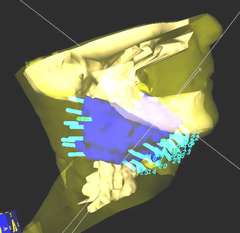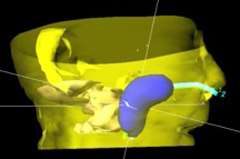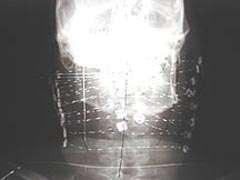Head And Neck Cancer – Brachytherapy
Find your care
Radiation oncologists use a patient-centered approach and individualized treatment plans. To learn more and make an appointment with a UCLA radiation oncologist, contact us at:
Westwood - 310-825-9775
Santa Clarita - 661-287-0010
Santa Monica - 424-259-8777
Head and neck cancers include tongue, buccal mucosa (cheek), floor of mouth, oropharynx, palate, tonsil, parotid gland, nasopharynx, and lymph nodes in the neck. Brachytherapy can be done either with an interstitial implant or intracavitary implant but most implants done in this region are interstitial implant.
Type of Implant for Head and Neck Cases
Computer Dosimetry

3-D image of an interstitial implant for base of tongue cancer and right neck lymph node. The treatment catheters are aqua and the 100% radiation dose "cloud" is blue. The rapid dose reduction outside the implant, plus HDR’s ability to shape the radiation dose ensures that the doses to normal tissues such as the spinal cord and salivary glands are kept to a minimum.

3-D image is of an intracavitary implant for a nasopharyngeal cancer. Two treatment catheters are inserted through the nose and curve down the back of the throat. The shape of the isodose cloud is controlled by the ability to adjust the dwell times that the source spends in each catheter.

Salvage Case: This is a radiograph of an interstitial implant for a recurrent cancer in the oropharynx. The patient had previously received external beam radiation therapy. CET physicians were asked to perform salvage brachytherapy. Catheters were inserted to treat both sides of the neck and the posterior oropharynx. The radiation doses were shaped so that the spinal cord dose was not exceeded. This is achieved by the high level of dose control possible with the HDR brachytherapy system.
Benefit of HDR Brachytherapy for Head and Neck Cancer
Information for patients preparing for H&N interstitial brachytherapy (PDF)
-
Interstitial Implants
In interstitial implants, the catheters are inserted through tissue to encompass the tumor. Tongue, floor of mouth, tonsil, cheek , soft palate and neck nodes are examples of interstitial implants. Interstitial head and neck patients are treated with one implant. This type of complex brachytherapy is done in the operating room with the patient under general anesthesia. Six to 10 treatments are given over a period of 3 to 5 days during which time the patient is hospitalized.
-
Intracavitary Implants
Intracavitary means that catheters are inserted into the oral or nasal cavities to reach the tumor. Topical anesthetic is used to make the insertion of the catheters more comfortable. After the treatment is finished, the patient goes home. Usually, 3 to 6 treatments are given, separated by at least two days.
- Potential surgical disfigurement may be avoided and the structure and function is preserved.
- Nearby critical structures such as brain, spinal cord and eyes are spared from excessive radiation dose.
- In previously irradiated tumors where no further external radiation can be given, HDR brachytherapy can still be used to treat the tumor (salvage brachytherapy).
Our Head and Neck Cancer Experts:
